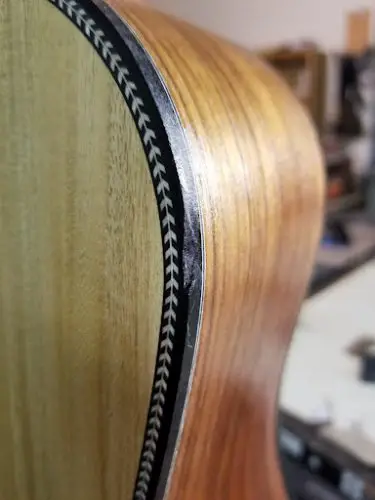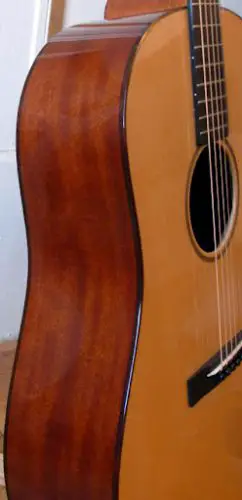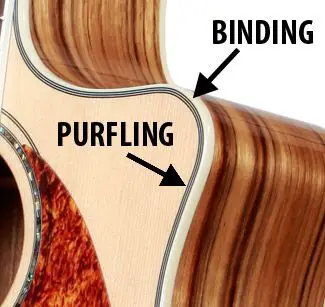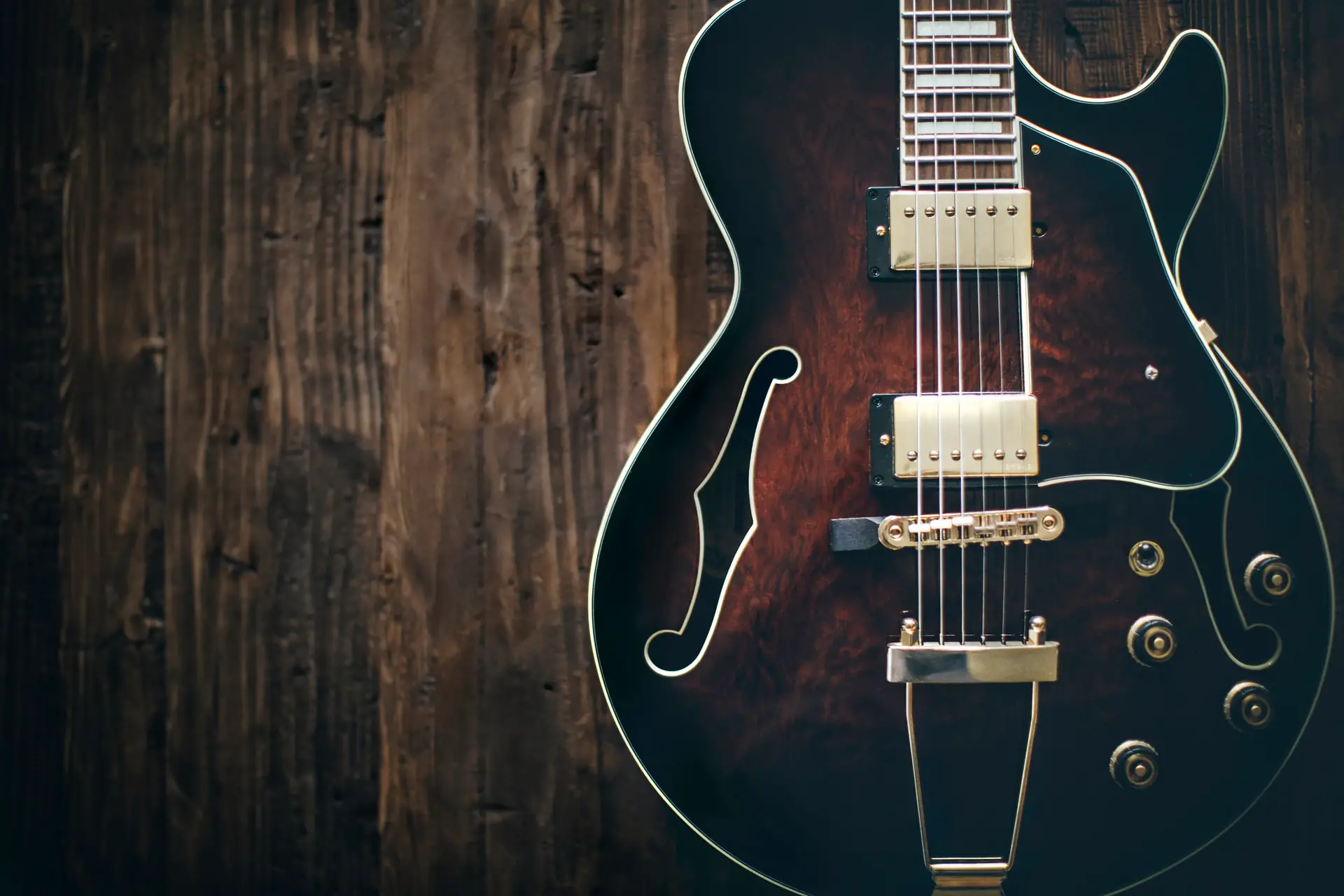Guitar binding is necessary to protect your guitar from chipping, nicks, moisture and splitting as it gets old. Guitar binding is great for protection and cosmetics but it’s not required to achieve great sounds.
Many cheaper guitars don’t come with binding out of the box because binding takes some time and it’s a delicate process.
Personally, I have owned guitars that come with binding and no binding. In this article, I am going to go into details about guitar binding.
We will cover common guitar binding questions like
- Benefits of binding guitar
- Does guitar binding impact tone
- Do you need to bind your guitar
- Materials for guitar binding
- Guitar binding vs purfling
After reading this article, I am sure you will be much more knowledgeable about guitar bindings and can even advise your friends on the topic.
5 Benefits Of Binding Guitar
Below are 5 benefits to guitar binding. We all know guitar binding is a protective layer – but what exactly do they project and what are the other benefits?
1. Cosmetic purposes
Bounded guitars simply look better than non-bounded guitars. It helps shape the guitar and gives the guitar an additional accent for contrast.
Guitar bindings can come in different colors and materials. The most obvious reason for a guitar binding is to make your guitar look better and stand out – especially if your guitar binding is made of thicker wood.
It’s best to purchase a guitar that comes directly with a binding because binding it yourself is difficult and it could be expensive to hire external help with guitar binding.

Guitar binding is a protective and decorative layer around the guitar body (and even neck or headstock).
2. Acts as cushion for guitar
Guitar binding protects the edges of your guitar from bumps, nicks and scratches. Guitar binding is great for cushioning because it’s usually made from stronger material than the guitar body.
With guitar binding, you can be less careful with your guitar and concentrate on your playing – instead of babying the guitar.
The edges of a guitar are usually the most vulnerable when it comes to scratches and dings. With a guitar binding, your guitar edges are protected – even more if the guitar binding covers the body, neck and headstock.
3. Seals the guitar to last longer
Guitar binding seals the top and back side of your guitar. This is great to keep out moisture from seeping in and also great for preventing your guitar from splitting with old age.
Moisture seeping into the guitar could be a disaster – it can age some parts of your guitar considerably more than others and also turn it yellow and brittle.
Also, a typical acoustic guitar has a big curve at the end of the body. If not taken care properly, the back and top of an old guitar can split at this area with the big curve.
With guitar binding, the guitar is sealed – keeping any moisture or water out. The guitar binding also holds the back and top side of your guitar firmly. Expect your guitar to last longer with a binding.
4. Smoother neck
Guitar binding on the neck area feels much smoother than without. This gives that ‘premium’ feeling to the guitarist when playing.
I personally like this feeling very much. It’s much smoother. It feels better for your fretting hand to touch and slide around.
No matter how hard you polish a guitar neck, it will not be as smooth as a neck with guitar binding.
5. Retain resale value
Guitar with bound body and neck typically have a higher resale value because it’s commonly understood that only the more expensive guitars come with binding.
Also, binding a guitar is a delicate process and takes some time. It’s great for protection and these reasons can be used to drive up the value of your guitar during reselling.
Though, it’s also possible to bind guitars with fake, cheaper materials. As a buyer you need to be careful about this.
Does Guitar Binding Impact Tone?
Guitar binding does not impact the tone of a guitar in any significant way. The tone should be the same for bound and unbonded guitars – regardless of acoustic, electric or bass.
In theory, areas near the guitar binding will not vibrate as much (because of glue and sealing). Which means bounded guitars will be less louder than unbounded guitars.
However, I haven’t noticed any change in tone or volume between a bounded and non bounded guitar. The change in vibration is too small and insignificant.
Most guitarists – especially beginners (including me) will not be able to hear any tone or volume difference between bounded and unbounded guitars.
Do You Need To Bind Your Guitar?
You are not required to bind your guitar to achieve anything extra. Guitar binding is just another layer of protection and cosmetic improvements.
If you have an unbounded guitar, then you don’t have to go and bind it. Just be more careful with the guitar and keep it safe.
When you are done playing, keep the guitar on a guitar case or guitar stand with a case. As long as you’re careful, your unbounded guitars can sound just as great and last as long as bounded guitars.
Though, if you have the budget and want to buy a new guitar, then I suggest going for guitars with neck and body binding. The guitar will look much better, last longer without scratches and feel smoother on the hand.
Materials For Guitar Binding
Guitar bindings are most commonly made from plastic, hard wood or fiber. They vary in look and strength – with plastic being the most common and come in most styles.
Personally, I think the wood binding looks and feels the best. This makes the guitar feel more premium. However, they are weaker and are prone to scratches and dings.
If you need guitar bindings with patterns and colors, then plastic binding is your best bet – they are the most popular and cheapest. Plastic guitar bindings can be made from Celluloid, ABS or CAB.
Fiber guitar binding is an option if you need tough bindings but like plastic, they don’t look so great. It’s all personal preference.
Beautiful bindings? Get wood binding. Durable bindings? Get plastic or fiber.

Wood guitar binding looks great and is much smoother compared to plastic / fiber bindings.
Guitar Binding Vs Purfling
Guitar binding is a decorative and protective layer around a guitar body, neck and headstock. They usually come pre-installed on more expensive guitars.
Guitar Purfling are thinner lines around a guitar binding to add color accents and styles. Purfling is used for looks and decorative purposes only.
You can install one without the other. Binding primarily for protection and purfling for decoration. They are usually used together though.

Purfling is for decorative purposes and binding is a protective bumper around a guitar.





